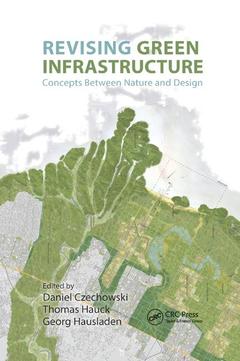Description
Revising Green Infrastructure
Concepts Between Nature and Design
Coordinators: Czechowski Daniel, Hauck Thomas, Hausladen Georg
Language: English
Subjects for Revising Green Infrastructure:
Keywords
Green Infrastructure; Green Functionalism – A brief sketch of its history and ideas in the USA and Germany; Green Infrastructure Plan; Carefully radical or radically careful? Ecology as design motif; Ecosystem Services; The City That Never Was – Engaging Speculative Urbanization through the logics of Landscape; Si Te; Landscape as energy infrastructure: ecologic approaches and aesthetic implications of design; Pa Ce; Counterpoint: The Musical Analogy; Periodicity and Rural Urban Dynamics; Va Ri; Storm Water Management; Fresh Kills; Landscape Architecture; Gr Av; Test Design; Le Ve; Fresh Kills Park; Landscape Machines; WSUD; Landscape Infrastructure; Green Functionalism; Green Wall; GGW; Wa Ar; River Aire; Odum Brothers; Wet Ponds; Ecological Network; Modern Pastoralism
Publication date: 10-2017
· 15.6x23.4 cm · Paperback
Publication date: 12-2014
488 p. · 15.6x23.4 cm · Hardback
Description
/li>Contents
/li>Biography
/li>
Consider this ?
- How do we handle the convergence of landscape architecture, ecological planning, and civil engineering?
- What are convenient terms and metaphors to communicate the interplay between design and ecology?
- What are suitable scientific theories and technological means?
- What innovations arise from multidisciplinary and cross-scalar approaches?
- What are appropriate aesthetic statements and spatial concepts?
- What instruments and tools should be applied?
Revising Green Infrastructure: Concepts Between Nature and Design examines these questions and presents innovative approaches in designing green, landscape or nature as infrastructure from different perspectives and attitudes instead of adding another definition or category of green infrastructure. The editors bring together the work of selected ecologists, engineers, and landscape architects who discuss a variety of theoretical aspects, research projects, teaching methods, and best practice examples in green infrastructure. The approaches range from retrofitting existing infrastructures through landscape-based integrations of new infrastructures and envisioning prospective landscapes as hybrids, machines, or cultural extensions.
The book explores a scientific functional approach in landscape architecture. It begins with an overview of green functionalism and includes examples of how new design logics are deducted from ecology in order to meet economic and environmental requirements and open new aesthetic relationships toward nature. The contributors share a decidedly cultural perspective on nature as landscape. Their ecological view emphasizes the individual nature of specific local situations.
Building on this foundation, the subsequent chapters present political ideas and programs defining social relations toward nature and their integration in different planning systems as well as their impact on nature and society. They explore different ways of participation and cooperation within cities, regions, and nations. They then describe projects implemented in local contexts to solve concrete problems or remediate malfunctions. These projects illustrate the full scope presented and discussed throughout the book: the use of scientific knowledge, strategic thinking, communication with municipal authorities and local stakeholders, design implementation on site, and documentation and control of feedback and outcome with adequate indicators and metrics.
Although diverse and sometimes controversial, the discussion of how nature is regarded in contrast to society, how human-natural systems could be organized, and how nature could be changed, optimized, or designed raises the question of whether there is a new paradigm for the design of social relations to nature. The multidisciplinary review in this book brings together discussions previously held only within the respective disciplines, and demonstrates how they can be used to develop new methods and remediation strategies.
Part One: Function & Process. Green Functionalism – A brief sketch of its history and ideas in the USA and Germany. Carefully radical or radically careful? Ecology as design motif. The City That Never Was – Engaging Speculative Urbanization through the logics of Landscape. Landscape as energy infrastructure: ecologic approaches and aesthetic implications of design. Landscape Machines, designerly concept and framework for an evolving discourse on living system design. Problems of the Odumian Theory of Ecosystems. Part Two: Culture & Specificity. The Machine and the Garden. Infrastructure design as a catalyst for landscape transformation: research-by-design on the structuring potential of regional public transportation. Beyond Infrastructure and Superstructure – Intermediating Landscapes. Landscapes of variance: working the gap between design and nature. Designing Integral Urban Landscapes – On the End of Nature and the Beginning of Cultures. Counterpoint: The Musical Analogy, Periodicity and Rural Urban Dynamics. Part Three: Governance & Instruments. A transatlantic lens on Green Infrastructure Planning and Ecosystem Services: Assessing Implementation in Berlin and Seattle. The concept of "new nature" – a paradigm shift in how to deal with complex spatial questions. Ecological Network Planning – Exemplary habitat connectivity projects in Germany. Planting the Desert: Cultivating Green Wall Infrastructure. Designing for Uncertainty The Case of Canaan, Haiti . Part Four: Applied Design. Water-Sensitive Design of Open Space Systems Ecological Infrastructure Strategy for Metropolitan Lima, Peru. Green Infrastructure: performance, appearance, economy and working method. The Caribbean Landscape Cyborg: Designing Green Infrastructure for La Parguera, Puerto Rico. Forests and Trees in the City: Southwest Flanders and the Mekong Delta.




